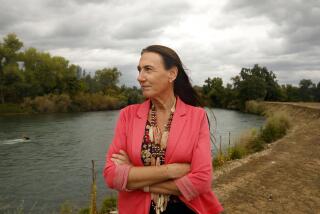Washington State Tells a Latter-Day Tale of Two Cities
- Share via
REDMOND, Wash. — Darrin Allison doesn’t know what happened to the town he grew up in, but he knows it’s gone.
Sitting in a stubbornly blue-collar Redmond diner where the smell of grease and cigarettes lingers in the air, Allison remembers chasing salamanders through the woods and fields of Redmond as a boy in the 1960s.
“It was rural. Idyllic,” he says. But the open spaces were chewed up by office parks and housing developments Allison and his friends can’t afford. Of his childhood buddies, he alone still lives in Redmond.
“Microsoft, Nintendo. It’s a high-tech identity,” he said. He doesn’t begrudge Redmond its success. But the town has outgrown its farming roots, and in a way it has outgrown him.
“The quality of life has gone down,” he says sadly. “I don’t think you can say it hasn’t.”
About 110 miles to the southwest, Shelli Hopsecger, 32, gives an enthusiastic tour of the Grays Harbor Port in Aberdeen, pointing out vast tracts available for development.
Like Allison, Hopsecger is the only one of her childhood friends who lives in Aberdeen. Cheap housing is plentiful in her hometown; her classmates moved away because they couldn’t find jobs. The logging downturn in the 1980s and ‘90s hit this town hard.
“I was one of the lucky ones,” says Hopsecger, public relations director for the port.
In Aberdeen, the problem is not too much growth, but lack of it.
Both areas are struggling with their identities--Redmond to keep its character, and Aberdeen to find a new image. It’s a contrast repeated across the West, as some towns reap the benefits of booming high-tech economies while others struggle to become less reliant on the dwindling natural-resources economy that defined the old West.
Aberdeen leaders don’t want the growth that has overwhelmed Puget Sound cities like Redmond, but they admit they could use just a touch of it. Redmond grew 7,800% in the last 50 years, and Aberdeen’s population declined 16%.
For the first half of the 20th century, Aberdeen entrepreneurs would have laughed at the notion that one day the sleepy farm village of Redmond would overtake them in prominence and population.
The port city of Aberdeen was founded in 1890, named after a local fish-canning company with stockholders in Scotland.
Aberdeen’s lumber mills helped build the West. When San Francisco burned after the earthquake of 1906, Aberdeen and nearby Hoquiam supplied the wood to rebuild it.
“Aberdeen from its beginning really perceived itself as a player in the world economy,” said Grays Harbor Chamber of Commerce President LeRoy Tipton.
The 1895 opening of the railroad --with the line to Aberdeen financed by local businessmen and built by local laborers--spurred the city’s biggest boom. The 1890 population of 1,638 people jumped to 13,660 in 1910. The population peaked in 1930 at 21,723. In 2000, it had fallen to 16,461.
Meanwhile, Redmond was a backwater named Salmonburg, notable only for abundant dog salmon in the surrounding streams. The hills were logged in the early years, but by the 1920s most of the virgin forest was gone and logging was replaced by dairy and chicken farms.
The population was 300 when Redmond incorporated in 1912, and stayed below 1,500 until 1960. The town was isolated from Seattle’s growth by Lake Washington, and for a long time it had only one stoplight.
The opening of Evergreen Floating Point Bridge in 1963 fueled Redmond’s biggest spurt of growth, from 1,426 in 1960 to 11,031 in 1970 to 45,256 in 2000.
With easy access to Seattle, Redmond took off. Its new identity took shape in 1986, when the growing Microsoft company relocated from Bellevue to Redmond. But Redmond does not live or die by Microsoft alone. When a federal court ordered the company to break up last year, an order still being appealed, most Redmond residents yawned. The town has plenty of other employers, from Nintendo to Eddie Bauer, to sustain its economy.
The growth has been good for small businesses too. Victor’s Celtic Coffee Company, an independent cafe, has prospered as Redmond grew over the last decade.
“When we first moved to Redmond, you wouldn’t see a soul on the street after six o’clock,” owner Victor Harding said.
But the growth that nurtured his business also burned him out. He and his wife are moving to Cannon Beach, Ore., in search of the peaceful lifestyle that Redmond once promised.
“We’re ready to just slow it down, live a little simpler in a quieter town,” he said.
Slowing growth is a big concern in Redmond. Traffic is the main complaint as little farm-to-market roads have been overwhelmed by growth. The city is trying to encourage more livable development. And a historical society formed just two years ago to try to preserve what’s left.
“Some people feel like they’re losing the identity of the town,” said Redmond planner Dianna Brodie. “We’re seeing a push for historic preservation. There are some mixed feelings.”
Aberdeen didn’t have the luxury of mixed feelings when the timber industry took a nose dive in the 1980s and 1990s. A recession and restructuring in the 1980s were followed by new environmental regulations in the 1990s, notably the protection of the spotted owl.
Diversification is the watchword as the area slowly climbs out of its depression. The timber company Weyerhaeuser is still the largest employer in Aberdeen, followed by the hospital and a state prison. But city leaders are trying with some success to recruit different companies, from secondary wood product manufacturers to high-tech enterprises.
While city leaders may view Redmond’s strong tax base and low unemployment with envy, many Aberdeen residents think their growth-deprived town is just fine the way it is.
More to Read
Sign up for Essential California
The most important California stories and recommendations in your inbox every morning.
You may occasionally receive promotional content from the Los Angeles Times.













